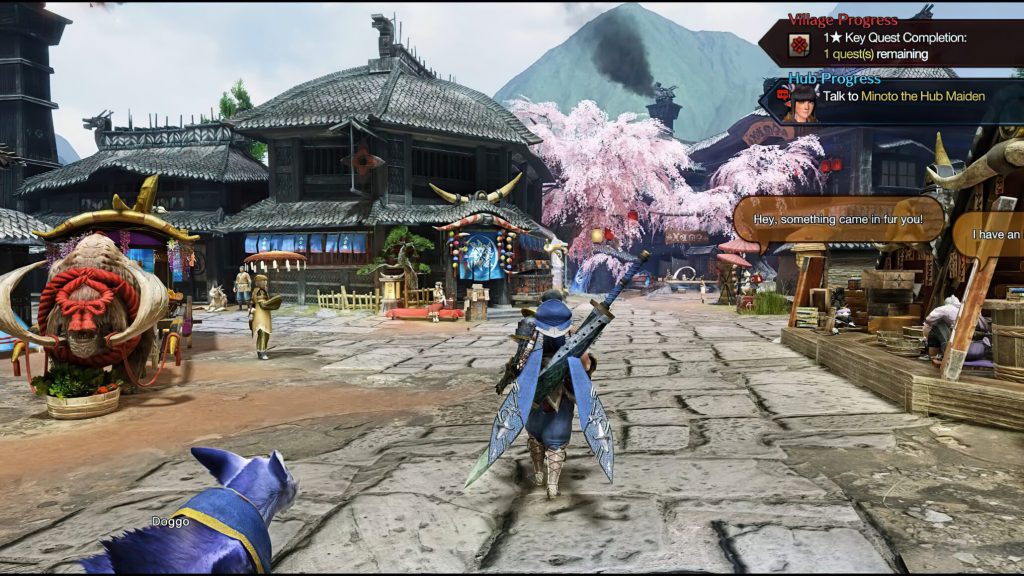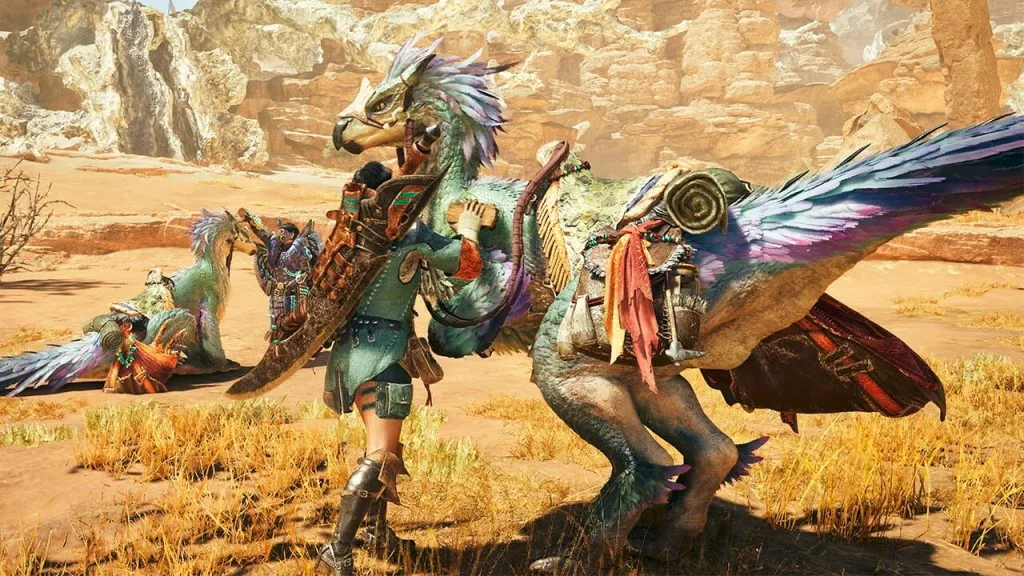The Monster Hunter Wilds game review reveals an ambitious attempt to reimagine the classic monster hunting formula. The project departs from the usual conventions, adding non-linearity, freedom of exploration, and a large-scale approach to the world around them. Instead of the usual quest structure, the player is presented with an open-world environment filled with interactions, events, and evolving ecosystems. The visual style, new tactical elements, and dynamic conditions make each hunt exciting, turning the gameplay into a continuous chain of discoveries.
Monster Hunter Wilds Game World Overview
The new environment acts not as a backdrop, but as a full-fledged participant in the events. The behavior of monsters is directly influenced by the weather, time of day, and seasonal cycles. For example, massive predators only hunt during snowstorms, while other creatures become active during sandstorms. The procedural changes in the map create a sense of a real world where events occur independently of the player’s actions.
The game area is divided into several biomes, each with its own unique ecosystem. For instance:
-
High-altitude ridges: limited visibility, difficult terrain, and cold-adapted monsters.

-
Arid plateaus: open areas with few shelters, and aggressive predators are active during the day.
-
Green canyons: water bodies, elevation changes, and flying creatures dominate.
-
Hidden areas: unlocked when the climate changes or when story missions are completed.
This variability makes it necessary to review the strategy before each hunt.
Monster Hunter Wilds Gameplay Review: Controls and Dynamics
 Unlike the previous installments, the gameplay in Monster Hunter Wilds becomes less tied to a head-on confrontation. Now combat is only a part of hunting, giving way to exploration, tracking, and interaction with the fauna. The player can switch between movement, aiming and scanning modes. The focus system allows you to analyze the behavior of monsters from a distance and choose the moment to attack. There is an opportunity to hide, use natural traps or set one monster on another.
Unlike the previous installments, the gameplay in Monster Hunter Wilds becomes less tied to a head-on confrontation. Now combat is only a part of hunting, giving way to exploration, tracking, and interaction with the fauna. The player can switch between movement, aiming and scanning modes. The focus system allows you to analyze the behavior of monsters from a distance and choose the moment to attack. There is an opportunity to hide, use natural traps or set one monster on another.
Monster Hunter Wilds Mechanics: Depth and Variability
The mechanics section demonstrates the development of every aspect of the series. Resource gathering, crafting, movement, and combat have all changed:
- An in-depth hunting system. Each creature reacts to smells, noise, and environmental changes. The hunter must consider the wind direction, use baits, set traps, and slow down the prey. The monster may injure the player or destroy equipment, affecting the outcome of the battle.
- Interactivity with the world. The player uses elements of the landscape: rolling down slopes, hiding in thickets, and throwing boulders from a height. This expands the options for action and creates a dynamic pace of hunting.
Monster Hunter Wilds Co-op: Hunting in a Team
Cooperative mode is an essential component of Wilds. Hunting together in a team of four introduces a new level of strategic depth. Players can combine abilities, divide roles (traps, support, damage), and create synergies between builds. The monster adapts to the number of hunters. Increased aggression, enhanced attacks, and additional health force players to work together. The division of tasks among team members determines the outcome of the battle, while the use of cooperative skills accelerates the hunting process.
Overview of the plot of the game Monster Hunter Wilds
The story develops non-linearly. The player is not offered a standard set of tasks, instead introducing the concept of event progress. Each action affects the development of the surrounding world and unlocks new branches of the narrative. Settlements, camps and tribes are present on the map. By coming into contact with them, the hunter opens up access to unique tasks, new recipes and equipment. The choice of faction affects the available resources and the attitude of the world towards the user.
Weapons in Monster Hunter Wilds: Combat Tools
The Monster Hunter Wilds game review highlights the variety of weapons. Each type has a well-developed progression tree, usage features, and unique special moves:
-
Thunder Blades: balanced in damage and speed.
-
Energy hammers: powerful but slow.
-
Remote crossbows: work in conjunction with poisoning, stunning, or elemental effects.
-
Throwing discs: a new addition to the arsenal that combines flexibility and precision.
Monster Behavior and Tactics in Monster Hunter Wilds
The monster system takes realism and interaction strategy to a new level. The developers have abandoned conventional behavioral patterns, introducing multi-layered AI mechanics. Now, each monster does not act according to scripts, but adapts to the surrounding conditions and the hunter’s actions. The behavior depends on the season, time of day, level of anxiety, and the presence of other creatures on the map.
Behavioral archetypes
Some creatures act in packs, coordinate attacks, and retreat when the alpha male is lost. Others, on the contrary, guard their territory and attack when approached. There are also predators that operate from ambush, patiently waiting for the right moment to strike from behind, and then quickly disappearing into the surrounding vegetation.
Hunting tactics
The monster’s behavior is constantly evolving. For example, when injured, the predator may retreat only to lure the hunter into a trap. Other individuals may start using environmental objects, such as pushing trees, destroying shelters, or using acid, poison, fire, or electricity. This approach requires complex planning and quick reactions. The player can no longer use the same tactics for all monsters, as each battle becomes a unique encounter with an intelligent foe that resists and adapts.
Reactions to external stimuli
Monsters in Monster Hunter Wilds perceive the world through heightened senses. Light, sound, and smell all become tools or obstacles in the hunt:
- Light. Some creatures perceive flashes as a threat and run away, while others become more aggressive. At night, light becomes both a lure and a risk.
- Sound. The rustling of footsteps, the clicking of a crossbow, and the sound of a projectile hitting the ground can all attract attention or trigger an attack. The volume and duration of the noise directly affect the detection radius.
- Smell. Monsters can sense blood and the smell of food. If one monster is injured and leaves tracks, another monster may follow them and engage in combat with the first monster. These events create spontaneous encounters where the player observes a battle between two predators and chooses the moment to intervene.
Mounts and Movement: A New Game Dynamics
Monster Hunter Wilds completely reworks the mechanics of world exploration. Mounts are combat, reconnaissance, and support partners. Depending on their type, they perform unique functions and change the pace of map exploration.
Multifunctional mounts:
-
Battle mounts attack enemies, allow you to strike while moving, and dodge enemy attacks;
-
Scout mounts move quickly, detect hiding places, react to smells and sounds, and lead to the monster’s lair;

-
Supportive mounts heal the rider, reduce fall damage, and protect against negative environmental effects (poison, heat, cold).
Mounts interact with their surroundings: they jump over rocks, swim across rivers, and fit through narrow passages. Some creatures can develop skills and adapt to the hunter’s style.
Is Monster Hunter Wilds worth playing?
 The Monster Hunter Wilds review leads to the obvious conclusion: the game has become larger, deeper, and more ambitious. Every element is well-designed, and every decision feels important. The difficulty is balanced, the co-op is inspiring, and the world is alive. This is not just a continuation, but a confident step in a new direction.
The Monster Hunter Wilds review leads to the obvious conclusion: the game has become larger, deeper, and more ambitious. Every element is well-designed, and every decision feels important. The difficulty is balanced, the co-op is inspiring, and the world is alive. This is not just a continuation, but a confident step in a new direction.
 en
en  ru
ru  de
de  ar
ar  es
es  nl
nl  hi
hi  fr
fr  it
it  pt
pt  el
el 



